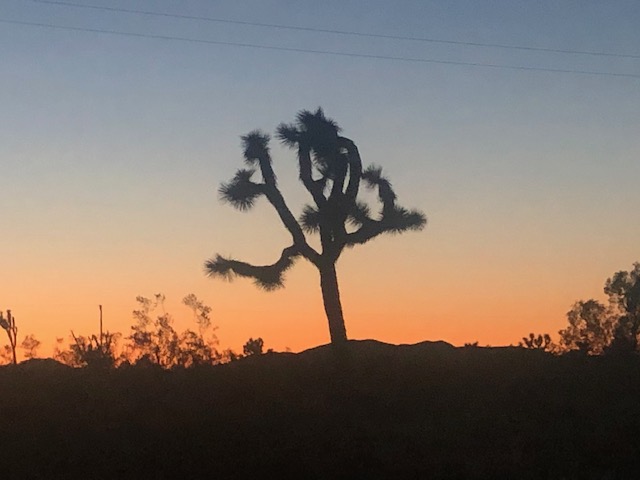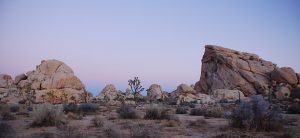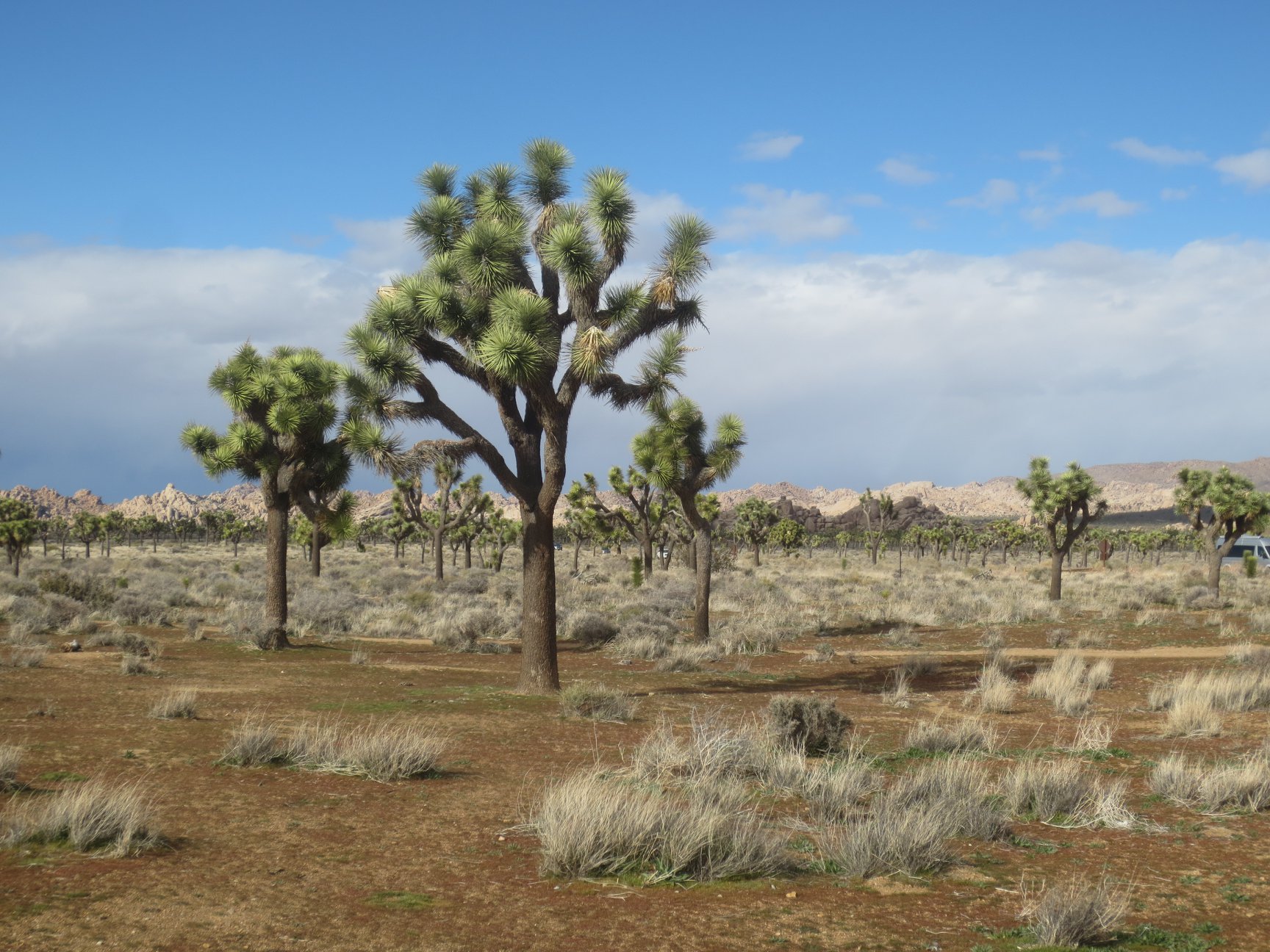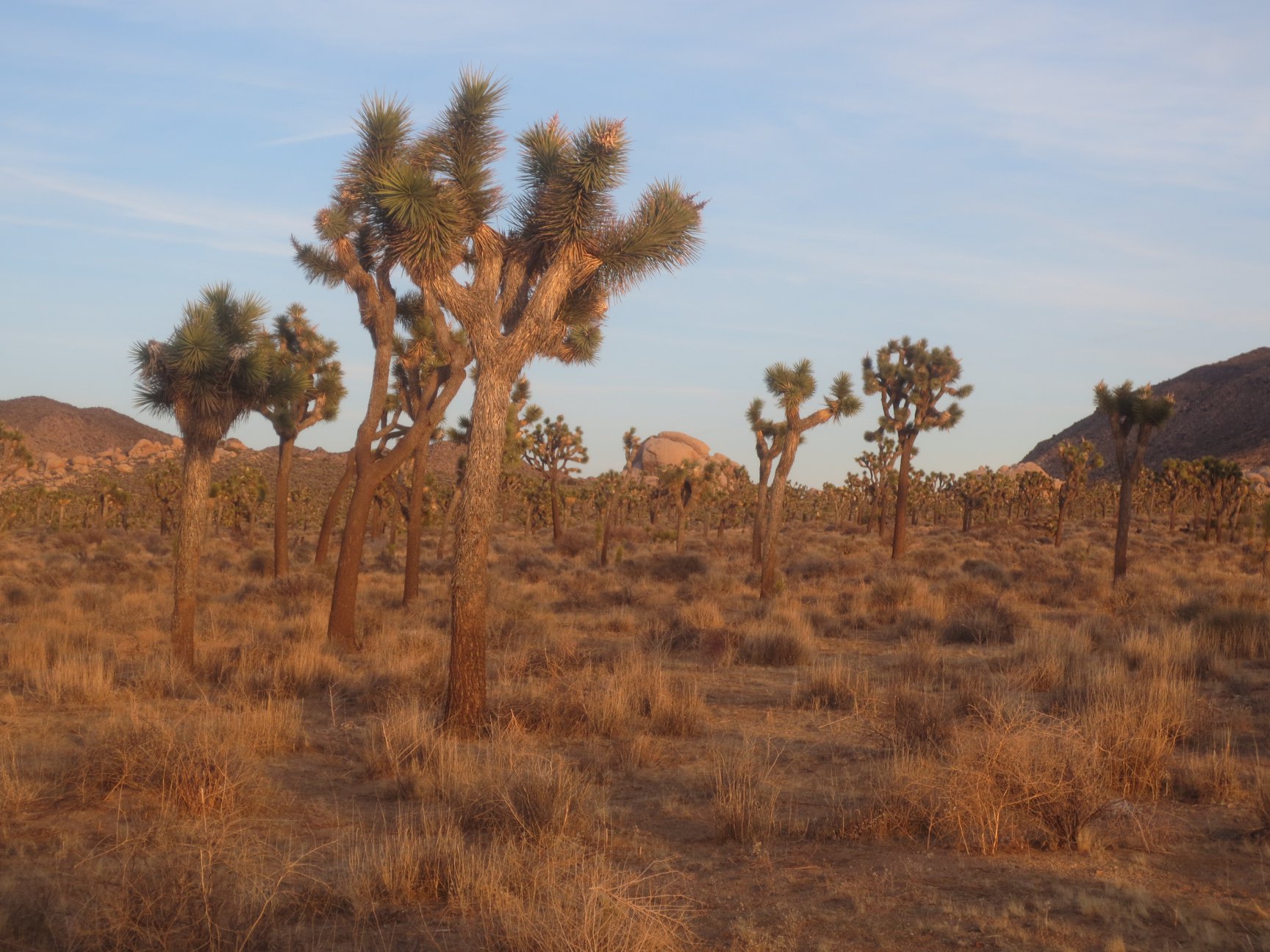
Joshua tree. (Photo: Laura Hauther for California Globe)
Conservationists Seek Greater Endangered Species Status for Iconic Joshua Tree
Various legal protections currently cover Joshua Trees
By Laura Hauther, June 23, 2020 10:13 am
The Joshua Tree, inspiration to musicians and artists, iconic symbol of the American desert and star of Instagram feeds the world over has once again taken center stage; this time in a tug of war between the rights of property owners and the need to protect a species in danger of decimation in a rapidly changing climate.
The Joshua tree, with its angular limbs ending in spiky evergreen bundles is an essential part of that special desert blend of nature, history and creativity that now draws over 3 million visitors to Joshua Tree National Park. Visitor numbers doubled in a span of just five years, making tourism an essential engine of economic growth in the area.
It seems to want to defy classification. Despite its name, the Yucca brevifolia is not a tree at all, it’s a succulent. Once classified in the Liliaceae, or lily plant family, it has lately been listed in the Asparagaceae or asparagus family. Capable of both sexual and asexual reproduction, it’s recently been divided into two species: the Western Joshua Tree and the Eastern Joshua Tree.

The desire to make sure the Joshua tree survives far into the future in a rapidly changing environment has lead to several attempts to strengthen protections.
Conservation group WildEarth Guardians tried to get the entire range in all three states – California, Arizona and Nevada – for both species of Joshua trees protected under the federal Endangered Species Act protection in 2015, but the petition was denied last year. That ruling is currently under appeal.
That spurred the Center for Biological Diversity (CBD) to file a petition with California’s Department of Fish and Game Commission in October of last year to get the Western Joshua tree endangered species status in the state.
Recently the Department of Fish and Wildlife filed a report supporting their request, and if the Commission accepts the recommendation, the Western Joshua Tree would receive endangered species protections while it’s in candidate status. That decision will be made at a meeting planned for June 24 and 25th. The permanent designation will be decided sometime next year.
Western Joshua trees are found near the San Bernardino and San Gabriel Mountains, west toward Gorman, CA and east into Nevada, where it shares part of its range with the Eastern Joshua Tree.
The Eastern Joshua tree is also some experiencing environmental pressures, but it’s situated in areas better suited for its survival, with cooler temperatures and higher rainfall.
The CBD petition gives an overview of struggles the tree is facing in certain parts of its range. It’s happiest between 4,000 and 4,600 ft, but at lower elevations with higher temperatures and less rainfall the trees are struggling and are not able to extend their range into higher elevations. Trees and plants are able to ‘move’ with the help of animals, but the Joshua Trees main helper, the giant ground sloth, has been extinct for thousands of years. Now their seeds are spread mainly by rodents. They also require a specific species of moth to in order to pollinate the flowers, and according the petition, “The flowering of western Joshua trees is considered episodic and rare” occurring only when rainfall is plentiful.
It can take many years for young tree seedlings to mature and reproduce. A study done as far back as 1989 found that only 19% of the seedlings were still alive after 22 years but none of them reproduced. Another study of three different sites in Joshua Tree National Park found populations of the tree declining over a 20 year period.
The studies used as the basis for asking for protection under the endangered species are focused on smaller areas and extrapolated from there. What they found are trees under increased stress as temperatures rise and average rainfall rates drop. Not only are older trees more likely to perish, but the rate of new tree growth reduced by almost 50%.
“They’re also under increased threat from wildfires,” Brendan Cummings, Conservation Director for the CBD told the Globe, “due to the proliferation of non-native grasses that dry out in the summer and add to the fuel load. Fires burn faster and hotter and many Joshua trees don’t have a chance when that happens.”
Laws and regulations aimed at protecting the Joshua tree have been in place for many years in an attempt to stop wholesale removal for development. Many were put in place after a growth spurt in the Antelope Valley in the 1980s resulted in as many as 200,000 trees being destroyed for various building projects.
But with more people drawn to the unique beauty of the high desert, there’s an increasing need for improved infrastructure in the area. Yucca Valley is in the middle of a multi-year project to connect the town to a sewer system, a move mandated by the state to protect the ground water.
Although the tree is currently covered under a patchwork of protections in both Los Angeles and San Bernardino Counties, as well as Hesperia, Victorville, Palmdale and the city of Yucca Valley, but many environmentalists think the Joshua Tree is going to need more help if it’s going to survive past the end of the century.
“Existing legal protections are unenforced and routinely ignored,” Cummings stated, “this designation will mean actual enforcement of these protections.”
Cummings said there are already endangered species protections in place for the desert tortoise, and given the overlapping habitat of the Joshua Tree and the tortoise, the procedures and costs for adding protections for Joshua trees will not have much impact on individual homeowners. Cummings said the bulk of any increased costs would for large building projects, like developments, retail spaces and energy plants.
Geary Hund, Executive Director for the Mojave Desert Land Trust agrees with Cummings’ assessment. In response to the concerns expressed by some in local government and the real estate industry, Hund said, “A lot of that is hyperbole. Homeowners could negotiate a permit for taking a tree for little or no cost, or by arranging to have it replanted elsewhere.”
Hund added that trimming a tree would be allowed as long as it didn’t kill the plant and homeowners could avoid the process altogether by planning around any existing trees.
But those opposed to the increased protections don’t buy these reassurances. They say once it’s added to the endangered species list, the added protections could mean more headaches, cost and delays for landowners, businesses and developers.
The Joshua Tree Gateway Association of Realtors (JTGAR) released a statement pointing out various protections currently covering Joshua Trees, like the 1977 California Native Plants Act covering plants in Imperial, Inyo, Kern, Los Angeles, Mono, Riverside, San Bernardino, and San Diego Counties. The California Environmental Quality Act (CEQA) requires an analysis and public disclosure of any project that may impact vulnerable species and requires builders to adopt plans for mitigation of harm.
They point to the 2.34 million acres of protected habitat in Joshua Tree National Park and Mojave National Preserve, adding that the Endangered Species protections will only serve to make it more difficult to build affordable housing in the area. With the rising cost of housing in the state, they say this will raise housing prices, leaving potential homeowners with fewer options.
JTGAR claims that the cost for building on a parcel with existing Joshua trees will cost between $60 and $90,000 and the required environmental impact study would take between 12 and 18 months.
In a video on their website, Monica Zimarik, President of JTGAR, also warns the endangered designation will also impinge on homeowner’s rights to build additional structures or landscape and make the compliance with the state’s mandated sewer connection more expensive and difficult.
San Bernardino County Supervisor Dawn Rowe echos these concerns in a phone interview, pointing out the act could have unintended consequences that could cause further harm to the environment in the area. The state mandated the switch from septic to sewer system due to the impact the septic systems have on ground water supplies, but if hook ups to houses and businesses are delayed, this important project may not happen as quickly as it should.
Rowe said she reached out to The California Fish and Game Commission President Eric Sklar about some of her concerns. “I asked what do you do when you have two competing state agencies with conflicting mandates, and the answer was…they didn’t know. They hadn’t really been faced with that before.”
Supervisor Rowe went on to say she doubts the reassurances that new restrictions on individual property owners would be negligible.
“The designation would require any private property owner be in compliance with California Environmental Quality Act (CEQA) for any activity that may disturb a threatened species,” Rowe stated, adding “it’s difficult to get clarification on the habitat impact aspect of the act, meaning even if a project would not result in a Joshua Tree being removed, it could still incur added delays and costs.”
Rowe sent out a letter to constituents, urging them to write to the California Fish and Game Commission to stop the protections from going forward, claiming that the Center for Biological Diversity acknowledges the species in not currently in decline.
Forty percent of the western Joshua tree’s range is on private land, making the Fish and Game Commission’s decision next week an important one for both the western Joshua tree and residents of the desert they share.








All things must pass. If the California environment is no longer conducive to the future of the tree, why must we punish the human beings that live here. What is wrong with simply letting the species survive in other more amenable areas outside the state? Can someone explain why placing a doomed tree on life-support at great expense and inconvenience to the citizens makes any sense.
As I mentioned in the article, there are many reasons to be concerned about the future of the Joshua Tree. If you’re not concerned about the ecosystem, there’s still the tourism industry. It’s the area’s economic lifeblood, built largely on the appeal of the Joshua Tree. The tree is not “doomed” yet – that is the point of getting the designation. Since most people, if they’re going to build, will go out of their way to preserve any Joshua Trees on their land because they part of the highly desirably picturesque landscape, it should not inconvenience many people.
But did any of these studies meet the scientific method: which is what if we did nothing at all, would the trees still survive? I bet no study did such a default study. This is mainly parasitism and stopping growth and development in the hinterland and diverting it to the big cities (where the coronavirus is!). Just because a property owner wants to clear cut his land doesn’t necessarily mean the demise of the species. I bet the zoning out in Joshua Tree is one dwelling per 5 acres or 20 acres. Which means a landowner would maybe clear cut a quarter acre pad for a house and the remaining 4.5 acres would remain with Joshua Trees. And what landowner wants the “trees” or “succulent” cut down when that scenic beauty and value to their property? Entire unnecessary land regulation by parasites.